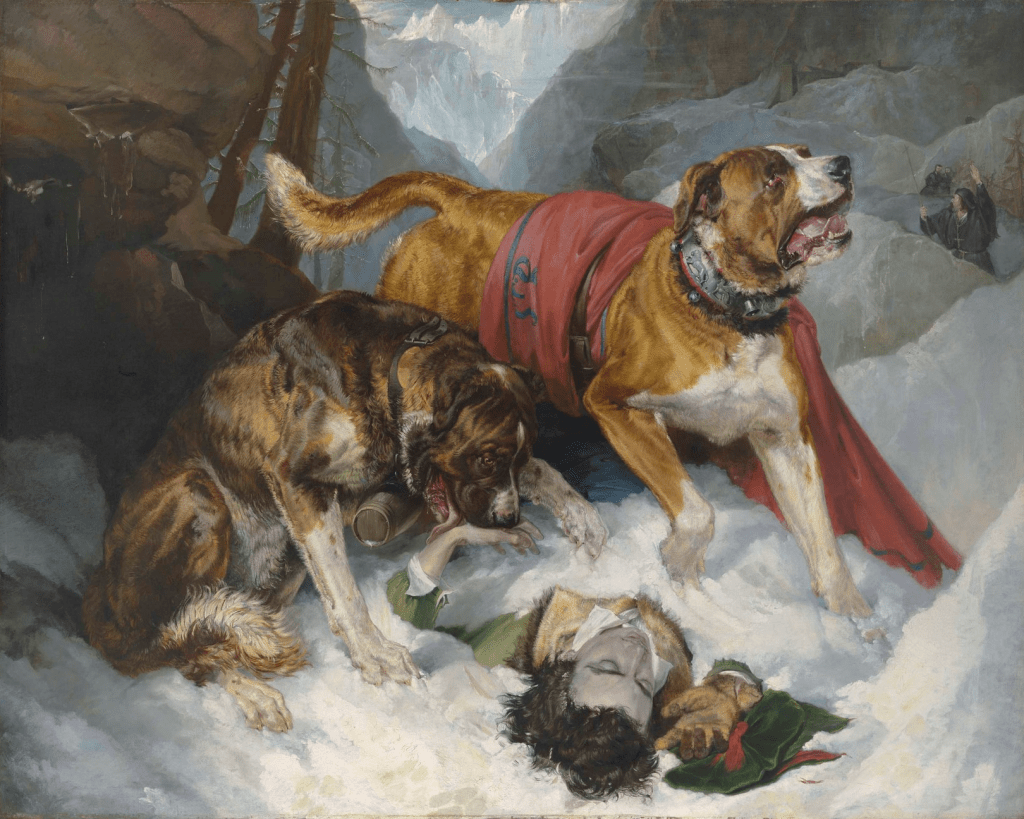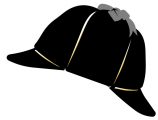Why does alcohol make you feel warm?
Alcohol makes you feel warm. This effect is so common and historically reported that both German and Russian military leaders recommended the prophylactic administration of alcohol to soldiers during World War II. And during WWI there was a months-long back and forth in the pages of The British Medical Journal debating the rum ration for soldiers. One of the contributors, E Musgrove Woodman, argued that alcohol “is only given out in cold weather, and is almost exclusively given to the troops actually in the trenches.”
A famous historical example of this, the brandy-toting St. Bernards are just a myth that emerged from an 1820 painting entitled Alpine Mastiffs Reanimating a Distressed Traveler.

In addition to the general sense that alcohol makes one feel warm, we have experimental data showing this. For example, a 1960 study placed participants in 59°F (15°C) water and gave them alcohol or nothing. Those who drank alcohol “felt much less cold… many described it as quite warm.”
Amazingly, this effect of alcohol is not unique to humans. In one study, goldfish were placed in either water or 1% alcohol. When exposed to alcohol, they swam to the colder end of an aquarium. This suggests their brains were saying, “hey fish, you’re pretty hot right now. Go cool off.”
Before we get to this general sensation of warmth, we need to explain the initial sensation of warmth/burning one feels in the esophagus as the alcohol is ingested. This results from activation of the vanilloid receptor 1 (VR1), also known as the capsaicin receptor.
Most of us know capsaicin as either the active molecule in chili peppers or as a pain medication. And, as we learned about in episode 28, this is the receptor that makes a UTI burn. Capsaicin, whether in chili peppers or in topical medications, is a big activator of the receptor. Another food product that does this is wasabi. But, for this topic, the key activator is temperatures greater than 109°F (43°C).
Alcohol potentiates the response of VR1 to capsaicin and to heat. This was noted in a 2002 study from the Department of Experimental and Clinical Medicine in Ferrara, Italy. The authors found that alcohol also lowered the threshold for temperature activation of VR1. As we mentioned earlier, the activation temperature is typically around 109°F (43°C). In this study, alcohol dropped the activation temperature to 93°F (34°C). This is lower than the esophageal temperature. Is the idea that a shot of alcohol will promote activation of the capsaicin receptor at normal body temperatures. When one does a shot of whiskey, a receptor would normally only activate at 109°F now gets activated at body temperature, a mere 98°F.
This may sound odd, but the sensation of warmth we feel occurs despite the fact that alcohol lowers our core temperature. There are a few potential mechanisms for this, but the one that’s been most studied is peripheral vasodilation. With this vasodilation comes heat loss through the skin and a lowering of the temperature.
A common misconception is that the feeling of warmth results from our skin feeling warm from the vasodiation and increased blood flow. In actuality, most studies, even those that demonstrate a drop in core temperature and increased feeling of warmth, don’t show an increase in skin temperature after alcohol ingestion. For example, a 2005 study by Yoda et al placed participants in a 91° (33°C) room and gave them either alcohol or water. Core temperature dropped in those who drank alcohol but not in those who who drank water. And although skin blood flow increased, alcohol also led to a decrease in skin temperature. Most importantly, despite the drop in core and skin temperature, participants who drank alcohol felt warmer.
The actual mechanism probably reflects something happening centrally, not peripherally. And it comes back to the idea of mismatch between the hypothalamic set-point and the core temperature. We discussed this in episode 24. Remember that if one’s set-point is raised by a pyrogen, say to 102°F (39°F) but your core temperature is only 99°F (37°C), then you are cold compared to what your body wants you to be. And so you feel cold and put on more clothes and seek shelter.
When one drinks alcohol, it is likely that the hypothalamic set-point is lowered. For example, maybe the set-point drops from 99°F (37°C) to 95°F (35°C). To get there the body vasodilates to dump heat through the skin. If you’re a fish, you’ll swim to colder waters. And if you’re at a soccer cold soccer game, you’ll say, “hey, this weather ain’t so bad” because your body is looking for a colder temperature anyway.
This is actually something that can be dangerous – feeling warm despite being colder and losing heat. Alcohol is one of the known risk factors for accidental hypothermia. Clearly the effect of alcohol on cognition are a huge factor too, but you might imagine that someone who feels warmer than they are might be at greater risk when exposed to dangerously cold weather.
Interestingly, one of the most famous survivors of the Titanic was purported to have been helped by having drunk alcohol just before the ship sank. Charles Joughin was the chief baker on the Titanic. He survived for two-plus hours treading water in the frigid Atlantic Ocean after the ship had sunk. The water was reportedly 28°F (-2°C) and he is one of very few survivors rescued directly from the water. During testimony before the British Wreck Commissioner’s Inquiry, Joughin reported that after the ship hit an iceberg he “went down to my room and had a drop of liqueur.” When asked to clarify he said it was a tumbler half-full of spirits. One of the questioners during the Inquiry, a Mr. Cotter, told the Commissioner that “I think his getting a drink had a lot to do with saving his life.” We couldn’t find clear explanation for what Cotter had in mind, but many articles have cited his having drunk alcohol as being a protective factor while in the cold water. His story is so famous that you can even see Joughin in the 1997 movie Titanic, taking a swig from a flank before the ship goes down.
Take Home Points
- Alcohol lowers the temperature at which the capsaicin receptor fires, leading to the burning sensation you feel after a shot.
- Alcohol also leads to a subjective sensation of warmth despite a decrease in core temperature.
- The mechanism behind the subjective sensation of warmth is likely central.
CME/MOC
Click here to obtain AMA PRA Category 1 Credits™ (0.5 hours), Non-Physician Attendance (0.5 hours), or ABIM MOC Part 2 (0.5 hours).
Listen to the episode
https://directory.libsyn.com/episode/index/id/27699270
Link to associated tweetorial
Credits & Citation
◾️Episode written by Tony Breu
◾️Show notes written by Tony Breu and Avi Cooper
◾️Audio edited by Clair Morgan of nodderly.com
This episode was sponsored by Brooklinen! Use promo code “CURIOUS” for $20 off your first order + free shipping.
Cooper AZ, Abrams HR, Breu AC. Feeling the Burn. The Curious Clinicians Podcast. August 9, 2023.
Image credit: https://nationalpurebreddogday.com/the-saint-bernard-brandy-cask-myth/

